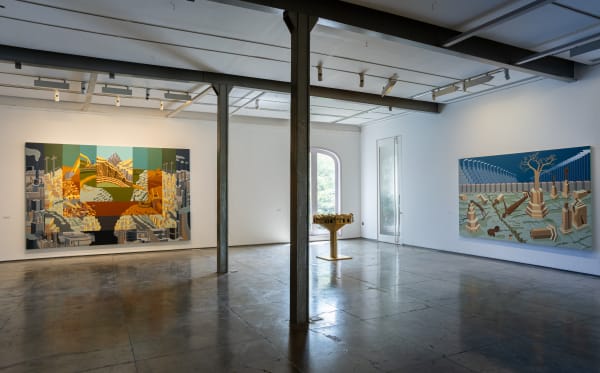Biophilia: Gigi Scaria
During the lockdown, we were inundated with images of dolphins dancing in the waters of the Bosporus; an unimaginably large number of flamingos roosting and breeding in the Talawe wetlands in Nerul; a puma roaming the deserted streets of Santiago. Nature did not merely make its presence felt. It sang, swam and walked the earth, reminding us that the propertarian approach of human beings, with its extractivist logic, has its limits. Thus, when Gigi Scaria decided to title his recent show after the psychoanalyst Erich Fromm’s inclusive concept of ‘biophilia’, a love for all life, I looked forward to the insistent presence of nature, regardless of built form.
These paintings, sculptures and videos are melancholic in their tonality. Here, the earth is sliced and quarried; the buildings inhabit an Escheresque nightmare, implausible constructions standing precariously on a prayer and an optical illusion. A filigreed shadow of branches spreads across the ground in some of the paintings. Or is that land fissured by endless infrastructure activity? In another canvas, an elephant is trapped in a scaffolding on a construction site. Or is it the shadow of an elephant that an illusionist has conjured up in a hyper-capitalist urbanscape? A dam forms the backdrop to this site, its gushing water transformed into a soft curtain. Perhaps the artist is nudging us to lift this curtain to expose our delusion that we are a sovereign species that can dominate over all beings, big and small, on this planet. To emphasise his position, in one of his paintings, Gigi pulls heroic statues off their pedestals and plants green thoughts in their place. In the centre, he installs a golden tree as a monument to the miraculous. One of Gigi’s bronze sculptures, bearing a green and gold patina, depicts tonsured earth. And yet, he transforms this quarry into a large lotus flower, in the stubborn belief that, no matter what, “nature will assert itself.”
Although Gigi may have chosen to name his show ‘Biophilia’, I would argue that it portrays, in the main, what Fromm would have described as a ‘necrophilic’ state, premised on a love for death, decay and destruction. Except for the rare presence of a human being (a girl attempting a holding action), a cat or an elephant in a dystopian landscape and an eagle perched on a dead tree, there are very few signs of life in these works. Posing ‘necrophilia’ as a threat, Fromm contended that in the race to produce and consume more and more in a capitalist economy, human beings have destroyed precious ecological resources. He espoused a biophilic ethic over a necrophilic attitude, an ethic that foregrounds interdependence among all species. Gigi sets up elaborate tableaux of the Baudrillardian ‘desert of the real’, but he remains an ardent biophiliac. Gently, he diverts our gaze to the golden branch and the green trunk moist with sticky sap.
Nancy Adajania










